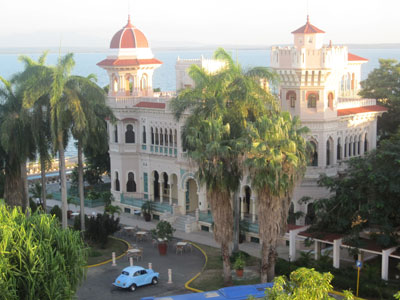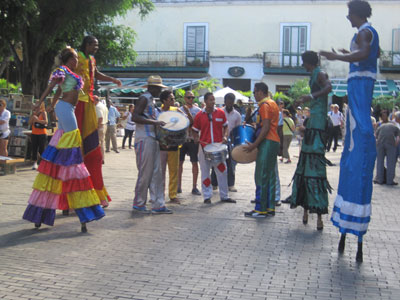Road Scholar tour of Cuba
This item appears on page 28 of the August 2014 issue.
I am not a tour person. I’m not into “Everybody out for volleyball,” stops at the tour guide’s brother-in-law’s shop, 5 o’clock dinners at senior center mess halls and having my luggage ready to go outside my hotel door at 6 a.m.
However, I’m fascinated by Cuban architecture, culture, food and art and have long had Cuba on my bucket list, and, since authorized group tours for supposed educational, scientific, cultural, humanitarian or religious purposes are the only legal way for US citizens to visit Cuba, I opted for a 7-day “Person to Person” tour with Road Scholar (Boston, MA; 800/454-5678).
(Many Americans go to Cuba unofficially through Montreal, Mexico or Caribbean nations, and passports are not directly stamped, but if they run into a problem of almost any kind, they don’t have the US government behind them. Also, if discovered and prosecuted, the fine can be $7,500.)
Road Scholar has a good track record, and this tour, Dec. 4-12, 2012, was priced on the medium-high end of many varieties of tours offered. It departed from Miami and cost me about $3,500, including travel insurance (highly recommended for Cuba), single supplement for a private room, and virtually all costs other than one dinner and the very occasional personal side trips we took.
Our first four nights in Havana were at Hotel Nacional de Cuba (Calle 21 y O, Vedado, Havana), built in 1930 and meticulously rebuilt and maintained. The hotel’s history hall features photos and Cuban-style caricatures of its many famous guests.
Our stay there was certainly a highlight and included three fine lectures by academic and government officials on architecture, economics, religion and society. The speakers were surprisingly frank about the general poverty of most Cuban citizens, particularly about the lack of adequate housing and public transportation. However, the free public medical system was highly touted and given as the prime reason few Cubans would emigrate to the US, even if they could.
Other highlights in Havana included Revolution and Old Havana squares, the Cuban Fine Arts Museum and the 1925 Hotel Ambos Mundos (153 Obispo, Havana, Cuba), which contains the room Ernest Hemingway used for seven years on his first visit to Cuba in the ’30s.
Our final three days were spent in and around the small city of Cienfuegos, where worthwhile stops included the colonial cities of Santa Clara and Trinidad, the Bay of Pigs and Che Guevara museums, a performance by the Cienfuegos Gospel Choir, and a ballet by two 12-year-olds at the Benny Moré School of the Arts.
In general, I felt very controlled and would have appreciated more walking and free time and less talk. Other than on one free evening, we were discouraged from being on our own.
An example of this control happened mid-afternoon on our last day in Cienfuegos, when a scheduled visit was suddenly canceled. A number of us asked to get off the bus in this small city and wander our way back to the hotel, which was clearly visible and only a 20-minute walk away. Our guide was not pleased about this, but after a great deal of convincing, we were let off. While in the lovely town square, I spotted a beautifully maintained (and still running) 1939 Pontiac.
The meals on our tour could best be described as “interesting.” Traditional meals of fish, beans, chicken and rice were good, and an outdoor pig roast was first rate. An Italian meal of pizza and spaghetti was not first rate, but it couldn’t top our dinner at one of the numerous paladares, privately owned restaurants in beautifully restored houses, now allowed by President Raúl Castro.
That meal was presided over by a chef in full white regalia who attempted to carve a giant turkey (not a traditional Cuban dish) by hacking it with a large cleaver while sweating profusely. Completing our dinner were two large tubs of rice and potatoes.
We had our best Cuban meal with locals at another paladare on our one free night.
Most tour lunches and dinners were preceded by a drink, usually a mojito, and featured South American wine or local beer. My favorite was Bucanero, an excellent, smooth, dark Cuban beer.
With unnecessary stops and long bus rides, it often seemed as if a good 5-day tour was being stretched into eight days. Our itinerary continually changed and it was not clear why. But, given the complexity of arranging Cuban tours, Road Scholar did a good job.
I’m anxious to return, but only when I can visit on my own, as citizens of most other countries can, and have “libertad” in Cuba.
FRED STEINBERG
Riverside, CT


